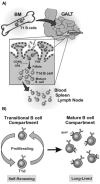Somatically diversified and proliferating transitional B cells: implications for peripheral B cell homeostasis
- PMID: 21525392
- PMCID: PMC3123885
- DOI: 10.4049/jimmunol.1003897
Somatically diversified and proliferating transitional B cells: implications for peripheral B cell homeostasis
Abstract
The peripheral B cell compartment in mice and humans is maintained by continuous production of transitional B cells in the bone marrow. In other species, however, including rabbits, B lymphopoiesis in the bone marrow abates early in life, and it is unclear how the peripheral B cell compartment is maintained. We identified transitional B cells in rabbits and classified them into T1 (CD24(high)CD21(low)) and T2 (CD24(high)CD21(+)) B cell subsets. By neutralizing B cell-activating factor in vivo, we found an arrest in peripheral B cell development at the T1 B cell stage. Surprisingly, T1 B cells were present in GALT, blood, and spleen of adult rabbits, long after B lymphopoiesis was arrested. T1 B cells were distinct from their counterparts in other species because they are proliferating and the Ig genes are somatically diversified. We designate these newly described cells as T1d B cells and propose a model in which they develop in GALT, self renew, continuously differentiate into mature B cells, and thereby maintain peripheral B cell homeostasis in adults in the absence of B lymphopoiesis.
Figures






References
-
- Allman DM, Ferguson SE, Cancro MP. Peripheral B cell maturation. I. Immature peripheral B cells in adults are heat-stable antigenhi and exhibit unique signaling characteristics. J Immunol. 1992;149:2533–2540. - PubMed
-
- Carsetti R, Rosado MM, Wardmann H. Peripheral development of B cells in mouse and man. Immunol Rev. 2004;197:179–191. - PubMed
-
- Allman D, Lindsley RC, DeMuth W, Rudd K, Shinton SA, Hardy RR. Resolution of three nonproliferative immature splenic B cell subsets reveals multiple selection points during peripheral B cell maturation. J Immunol. 2001;167:6834–6840. - PubMed
Publication types
MeSH terms
Substances
Grants and funding
LinkOut - more resources
Full Text Sources

